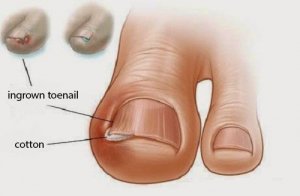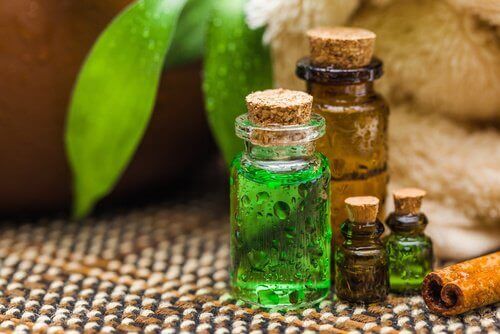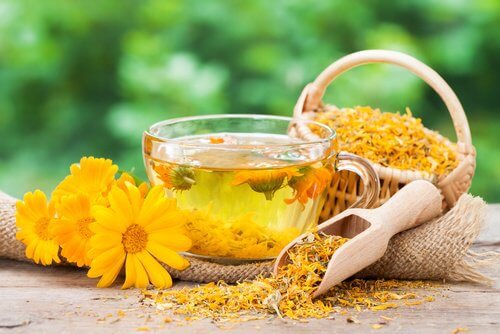6 Old Remedies for Ingrown Toenails


Reviewed and approved by the doctor José Gerardo Rosciano Paganelli
Onicoriptosis, better known as ingrown toenails, is a medical condition that occurs when the toenail becomes embedded in the skin of the toe. This is a common ailment, especially for those who don’t wear comfortable shoes made from breathable and flexible materials. Luckily, there are remedies for ingrown toenails.
Although it can occur in the hands, most of the time it appears in the big toe of one or both feet. In this article, we’ll discuss six age-old remedies for ingrown toenails.
Ingrown toenails are usually accompanied by redness and swelling. As such, they should be treated as soon as possible to avoid further issues.
While they don’t usually pose any major health risk, it’s important that you use a remedy to minimize the risk of infection.
Since many don’t know what to do about them, we’ll share six old, home remedies for ingrown toenails.
Remedies for ingrown toenails: tea tree oil

Tea tree essential oil is a natural product that has become known as one of the best antibiotics and antifungals.
Its use on the skin around the nails can help soothe irritation and redness in ingrown toenails.
Ingredients
- 6 drops of tea tree essential oil
- 1 cotton ball
- 1 bandage
What should you do?
- Firstly, try removing the ingrown nail from the skin using a cotton swab or ball.
- Then, apply the tea tree essential oil and cover the area with a bandage.
- Finally, leave it on overnight and repeat until you’ve completely healed.
2. Garlic
In addition to making your food taste wonderful, garlic has been recognized as a great natural remedy for many ailments.
Since it’s a great antibiotic, it fights inflammation and is soothing. As such, it’s an excellent solution for ingrown toenails.
Ingredients
- 1 clove of garlic
- 1 teaspoon of olive oil (5 g)
- A bandage
What should you do?
- Firstly, mash the clove of garlic with a mortar. Then, mix in the teaspoon of olive oil until you get a paste.
- Rub the paste on the affected area and cover it with a bandage to allow it to act for a few hours.
- Finally, repeat every day to ensure you relieve the ingrown nail completely.
3. Honey

Honey is a natural product with antibiotic and antiviral properties. Therefore, it can help protect the skin against all types of infections.
While it’s not a remedy for ingrown toenails or their removal, it may help to speed up recovery.
Ingredients
- 1 tablespoon of honey (25 g)
- 1 teaspoon of lemon juice (5 ml)
What should you do?
- Firstly, prepare a smooth paste with these two ingredients. Then, rub them on the affected area.
- Finally, wait 20 minutes before rinsing.
Find out more: The Benefits of Honey for Your Hair
4. Epsom salts
Epsom salts are a popular treatment for anything that has to do with foot disorders.
In addition, they contain anti-inflammatory, antifungal, and antibacterial properties that help alleviate this painful condition.
Ingredients
- 1 tablespoon of Epsom salts (10 g)
- 1 capsule of vitamin E
What should you do?
- Firstly, combine the vitamin E capsule with a tablespoon of Epsom salts. Then, use this mixture to exfoliate the affected area of your foot.
- Let it sit for 30 minutes. Finally, rinse with warm water and dry the area well.
- Repeat at least three times a week.
5. Calendula tincture

Another remedy uses calendula tincture. This flower has anti-inflammatory, antioxidant, as well as antifungal properties that soothe the irritation and infection from ingrown toenails.
Ingredients
- 10 drops of calendula tincture
- 1 liter of hot water
What should you do?
- Firstly, pour the hot water into a bowl and add the calendula tincture.
- Then, once it cools to a comfortable temperature for your skin, soak your feet for 15 minutes.
- Rub them carefully and dry them well.
- Finally, add some petroleum jelly or lotion to keep your feet moist.
6. White vinegar and hydrogen peroxide
Finally, the combination of white vinegar and hydrogen peroxide gives you an antifungal and antibacterial treatment.
Use it to reduce redness, pain, and the chances of infection.
Ingredients
- 2 tablespoons of white vinegar (20 ml)
- 2 tablespoons of hydrogen peroxide (20 ml)
- ½ cup of warm water (125 ml)
- 1 piece of cotton
What should you do?
- Firstly, dilute these two ingredients in warm water. Then, rub them over the painful nail using the cotton ball or swab.
- Leave it on for 20 minutes. Finally, repeat if necessary.
Read more about: 9 Home Remedies with Hydrogen Peroxide You Should Know
Is your ingrown toenail still bothering you? If the problem persists and becomes more painful over time, see your doctor.
Sometimes the only solution for ingrown toenails is to surgically remove them.
All cited sources were thoroughly reviewed by our team to ensure their quality, reliability, currency, and validity. The bibliography of this article was considered reliable and of academic or scientific accuracy.
- Daniel, C. R., Iorizzo, M., Tosti, A., & Piraccini, B. M. (2006). Ingrown toenails. Cutis. https://doi.org/10.4103/0378-6323.95442
- Zuber, T. J., & Pfenninger, J. L. (1995). Management of ingrown toenails. American Family Physician. https://doi.org/10.1111/j.1467-9868.2009.00728.x
- Haneke, E. (2012). Controversies in the treatment of ingrown nails. Dermatology Research and Practice. https://doi.org/10.1155/2012/783924
- Li G, Ma X, Deng L, Zhao X, Wei Y, Gao Z, et al. Fresh garlic extract enhances the antimicrobial activities of antibiotics on resistant strains in vitro. Jundishapur J Microbiol. 2015;
- Preethia KC, Kuttanb G, Kuttan R. Anti-inflammatory activity of flower extract of Calendula officinalis Linn. and its possible mechanism of action. Indian J Exp Biol. 2009;
This text is provided for informational purposes only and does not replace consultation with a professional. If in doubt, consult your specialist.








